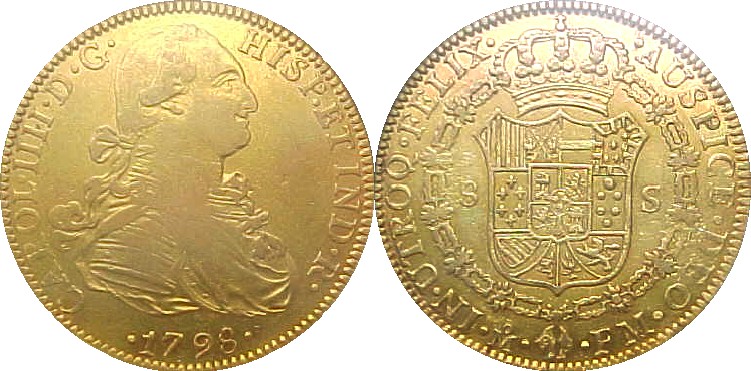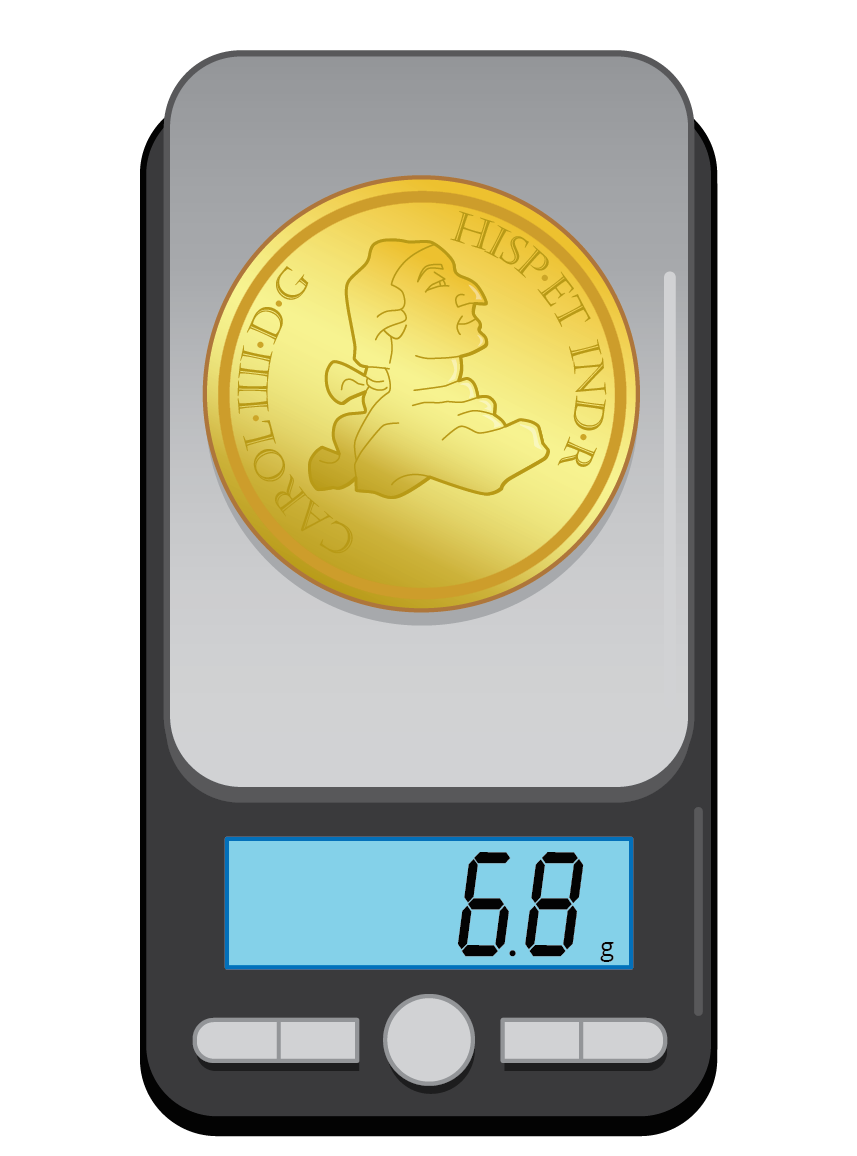Lesson 7
Round Doubloons
Warm-up: Notice and Wonder: A Digital Scale (10 minutes)
Narrative
Launch
- Groups of 2
- Display the image.
- “What do you notice? What do you wonder?”
- 1 minute: quiet think time
Activity
- “Discuss your thinking with your partner.”
- 1 minute: partner discussion
- Share and record responses.
Student Facing
What do you notice? What do you wonder?

Student Response
For access, consult one of our IM Certified Partners.
Activity Synthesis
- “What do you notice about the weights on the scale and the reading of the scale?” (They aren’t the same. The weights are 12.32 ounces and the scale says 12.3 ounces.)
- “Why do you think the scale and the weights don’t agree?” (The scale could be wrong.)
- “What if the scale only shows tenths of an ounce, and it can’t show hundredths of an ounce?” (The value is still not accurate but it’s the best the scale can do.)
- “In today’s lesson we will look at scales that show different numbers of decimals and see how that influences what they show.”
Activity 1: Gold Doubloons (20 minutes)
Narrative
The purpose of this activity is for students to round to the nearest tenth and hundredth. Students have rounded in earlier grades but this is the first time they round to tenths or hundredths. This is a direct extension of rounding to the nearest ten, hundred, thousand, and other whole number values. Locating the numbers on the number line will recall this earlier work.
The launch introduces the context of a doubloon, a major currency in Portugal and Spain in the seventeenth, eighteenth, and nineteenth centuries. Students round the weight of a doubloon to the nearest tenth and hundredth of a gram. In both cases, older doubloons are still heavier after rounding. Rounded to the nearest gram, however, they are the same. This is important from a practical perspective because it is easier to measure a weight to the nearest gram than it is to the nearest tenth of a gram or hundredth of a gram. It is also important because the numbers 6.9 and even 6.87 are not as complex as 6.867, and having fewer digits helps visualize the value more quickly.
Advances: Listening, Speaking
Launch
- Groups of 2
- Display the image.
- “This is a doubloon. What do you notice? What do you wonder?” (I notice 1798. I wonder if that’s the year it was made. I wonder if people actually used these as money. I notice there are words in a foreign language. I wonder what they say. I wonder what language it is.)
- “Doubloons were a major currency in Portugal and Spain in the seventeenth, eighteenth, and nineteenth centuries. Today, we are going to study the weights of doubloons.”
Activity
- “Take a couple of minutes to work on the first problem.”
- 2 minutes: partner work time
- “What does it mean to measure a weight to the nearest tenth of a gram?” (It means you find the closest tenth of a gram to the weight.)
- “How did you decide which kind of doubloon was on the scale?” (The older ones are heavier and the tenth they are closest to is 6.9 not 6.8.)
- “The weight of the doubloon is rounded to the nearest tenth of a gram.”
- “Now complete the rest of the problems.”
- 6–8 minutes: partner work time
Student Facing

- Until 1728, doubloons weighed 6.867 grams.
- After 1728, they weighed 6.766 grams.
-
You have a scale that measures weight to the nearest tenth of a gram.
Was the doubloon on the scale made before or after 1728?

- If you had a scale that measured to the nearest gram, explain why you would not be able to tell what year the doubloon was made based on the weight listed on the scale.
-
- Which doubloons weigh more, the ones made before 1728 or the ones made after 1728? Explain or show your reasoning.
-
Show the weights of the doubloons on the number line.
- Use the number lines to find which hundredth of a gram the doubloon weights are each closest to.
-
Student Response
For access, consult one of our IM Certified Partners.
Activity Synthesis
- Invite students to share their answers for rounding the weights of the doubloons.
- “How did you round the weight of the older doubloon to the nearest tenth? What about the nearest hundredth?” (It was closer to 6.9 than to 6.8, so I rounded to 6.9 to the nearest tenth. It was closer to 6.87 than to 6.86 so I rounded to 6.87 to the nearest hundredth.)
- “How did the number lines help you round the numbers?” (I could see on the number line which tenth or which hundredth the number was closest to and then knew to round it there.)
Activity 2: Exact or Approximate? (15 minutes)
Narrative
The purpose of this activity is for students to examine numbers in different situations and decide if they are exact or approximate. In most cases, there is no definitive answer but it is likely that the numbers are approximate or rounded. Two important reasons for using rounded measurements are
- it is easier to measure a length, for example, to the nearest kilometer or meter than to the nearest centimeter or millimeter
- round numbers can communicate the size of a quantity more clearly than exact numbers
For example, we might say that the classroom is 15 meters long. That number is probably not exact but it gives a good idea of the length. It is possible that 14.63 meters is more accurate but it is also cumbersome. The goal of the activity synthesis is to discuss some of the ways you can tell if a measurement is exact or rounded and what that tells you about the measurement.
Supports accessibility for: Conceptual Processing, Visual-Spatial Processing
Launch
- Groups of 2
Activity
- 2 minutes: independent work time
- 6–8 minutes: partner work time
- Monitor for students who
- recognize that the population of Los Angeles is approximate
- think that the time is exact
- think that the time is an estimate
Student Facing
Decide if each quantity is exact or an estimate. Be prepared to explain your reasoning.
- There are 14 pencils on the desk.
- The population of Los Angeles is 12,400,000.
- It's 2.4 miles from the school to the park.
- The runner finished the race in 19.78 seconds.
Student Response
For access, consult one of our IM Certified Partners.
Activity Synthesis
- Invite students to share their reasoning for the population of Los Angeles.
- “Why is the population of Los Angeles different than the pencils?” (There are so many people in Los Angeles that you can’t count them all. The pencils I can count one by one and be sure of my answer.)
- Invite students to share their reasoning for the time of 19.87 seconds.
- “Why do you think the measurement could be exact?” (It’s really precise. If it said 20 seconds then that sounds like an estimate but 19.87 seconds looks too precise to be an estimate.)
- “Why do you think the measurement could be approximate?” (It’s like the doubloons. There could be some thousandths of a second and then 19.87 seconds is just an estimate.)
Lesson Synthesis
Lesson Synthesis
“Today we looked at different quantities and saw that they are not always exact. We related this to the idea of rounding decimals.”
Display:
45 minutes
44.8 minutes
44.764 minutes
“Which of these quantities would you use to describe how long one of your classes is? Why?” (I would say 45 minutes because that’s what I would be able to tell from the clock and I understand what that means. I would not use the decimals because that does not tell me anything important about how long the class lasted.)
Cool-down: A Golden Dollar (5 minutes)
Cool-Down
For access, consult one of our IM Certified Partners.


